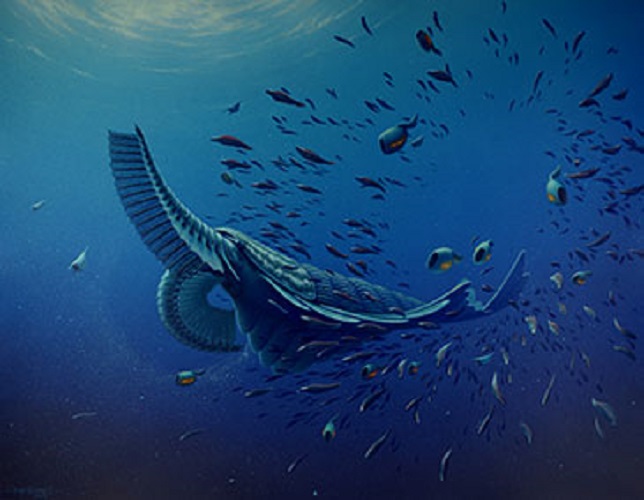 |
| A species of anomalocaridid displayed as a predator with large eyes, thick armour and spiked claws. Such a portrayal is not uncommon across the group |
Their superior size compared to almost all other creatures in the Cambrian seas gave them a distinct advantage over their prey. On the flip-side fossils have been found, particularly of hard shelled diminutive trilobites, displaying bite marks which correspond to the jaws of anomalocaridids. Yet were they all vicious hunters?
According to a new study, conducted by Dr Jacob Vinther from the University of Bristol, there may have been anomalocaridids which led a more relaxed lifestyle, using their appendages to filter feed. The research focused on Tamisiocaris borealis, a 520 million year old shrimp-like creature discovered in shales at the Sirius Passet fossil site in 2010. To fully understand how it may have lived the researchers constructed 3D models of Tamisiocaris which gave an indication as to the range of motions it could have made.
 |
| The long spined appendages of Tamisiocaris borealis |
The long spines would have trapped micro-organisms and edible detritus in the surrounding water, giving it an easy source of nutrition. Then by flexing the appendages inwards the spines would have formed a food-covered mesh close to the mouth from which the juiciest morsels could be extracted.
 |
| An artist's impression of how Tamisiocaris may have appeared as a filter feeder |
This makes Tamisiocaris rather like a whale in many respects. While it was a filter feeder, it was significantly larger than almost all other creatures in the ecosystem which would have given it a high degree of immunity against other predators.
'Feeding on the smallest particles by filtering them out of the water while actively swimming around requires a lot of energy and therefore lots of food,' said Dr Vinther. Research and discovery is an ongoing event in the localities which document the Cambrian Explosion. Even a hundred years after the early descriptions of the Burgess Shale fossils by Charles Doolittle Walcott, we are still unpicking the lives and interactions of the organisms which once inhabited the Earth during the greatest proliferation of life in evolutionary history.